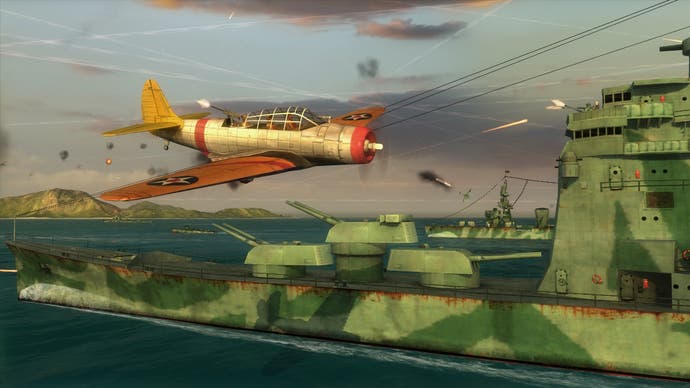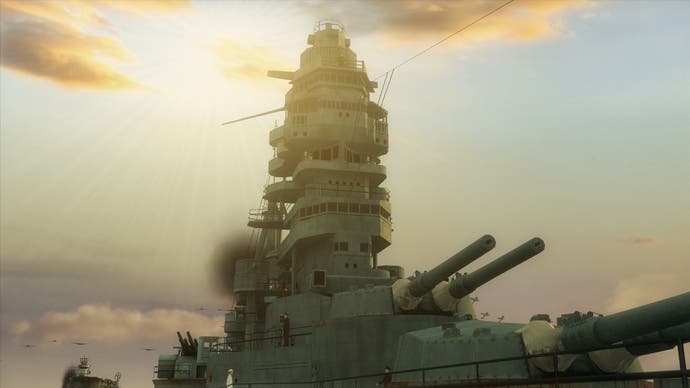Battlestations: Midway
Eidos' Naval battle sim is looking pretty rum.
There is a long tradition of showing off new videogames by hiring a glamorous and/or swanky location, dishing out a few trays of canapés and sticking a few demo units in to show off an early version of the game. Presumably when PR and marketing departments do this it's because they hope that the grotty game journalists they invite will write something nice about the game that they're showing off. But actually you book a location like HMS Belfast at your own risk, because, as a grotty game journalist it's very difficult to avoid getting drawn into writing about how brilliant the location is, instead of writing about the game in question.
Wandering down into the labyrinthine bowels of the Royal Navy's heaviest ever cruiser, it was surprisingly easy to get distracted by the frighteningly realistic mannequins round every bulkhead - from the ship's dentist to the tuck shop (or whatever the proper nautical name is) and its antique Kit-Kats and tins of beans. The big torpedoes and huge hunks of technical metal dotted around the corridors are equally riveting (sorry). But upon eventually arriving at the function room that Eidos had hired to show off Battlestations: Midway it was equally easy to get lost in the game's panicky multi-tasking charms. At least until the canapés arrived fresh from the ship's galley anyway.

Still, before the ham sandwiches arrived it was possible to get a good idea of how the finished game will play now that it is finally due to be released (having, at one point, been scheduled to appear on the Gizmondo. That's not happening any more). As the title suggests, Battlestations: Midway is set during World War II. It depicts various naval and aerial battles before reaching a climax at Midway - the decisive battle in the war for the Pacific, in which American forces surprised the Japanese navy, preventing it from establishing an advance base and puncturing its apparent supremacy.
The game was introduced by a quick hands-on with a mission from the single-player campaign - by diving into a mission that, appropriately enough, takes place midway through the game. The mission, called Strike on Tulagi, involved ensuring the survival of an aircraft carrier while destroying an airfield and dockyard, before escorting several landing craft to safety. It proved a useful introduction to the game's mix of real-time strategy and direct control, demonstrating the way in which you have to multi-task - ordering units around on a strategic map or switching quickly between units, before taking direct control of critical strikes or to defend against crucial attacks. It also included a good mix of the battleships, aircraft carriers, submarines and planes that will feature in the finished product.

And although the range of options and the multi-tasking pressure of the mission goals initially felt a bit bewildering, getting to grips with the game was actually reasonably intuitive. In any case, the structure of the single-player campaign will provide a gentler introduction, with players starting out as new recruit Henry Walker on his first assignment as a gunner at Pearl Harbor before gradually building up to take responsibility for increasing numbers and types of units. Indeed it'll apparently be possible to take charge of up to 60 units by the end of the 11 campaign story missions and 12 bonus challenge missions.
By the time you're controlling that number of units you'll probably be spending a lot of your time on the strategic map, reached via the Back button, where it's possible to assign targets and waypoints, and keep an eye on the overall layout of allied and enemy units. But one of the key features of Battlestations is the opportunity to take direct control of your units - both in the air and in the sea. You can switch between them using the d-pad and then use the left and right Sticks to move and shoot, or you can simply tap the X button to bring up a quick menu to assign them simple tasks (such as attack an assigned target) before switching to the next unit. Meanwhile the right bumper brings up a context-sensitive menu to allow you to, for example, launch planes from an airfield or aircraft carrier, or build and launch ships from a shipyard. And the left bumper assigns repair crews on ships to repair different parts of the ship.

It might seem reasonably complicated when written down, but in practice it does a good job of hiding the game's considerable complexities - many of which are borne of a dutiful commitment to realism. It's obvious that shortcuts have been taken to make the game more playable and to fit it onto a console, such as the decision to feature unlimited ammo (although torpedoes are limited, so you'll need to factor in the time it takes to return to base and reload).
But considerable effort has gone into keeping the grognards happy: at one point a helpful Eidos employee pointed out the three masts on the incoming destroyer that distinguished it as an enemy ship. A similar attention to detail means that targeting a plane's engines will take them out quickly and shooting ships under the waterline will flood them. In all there are over 45 classes of ship, 24 classes of plane and 17 other vehicles, and choosing the right unit for the job is crucial to the player's success (there's little point sending a plane equipped with machine-guns to take out enemy ships, but you might want to use them to defend a torpedo-bomber while it does the job, for example).

Unsurprisingly, the focus shifts slightly when it comes to multiplayer games, which was the next bit of the presentation, and, Eidos hopes, a large part of the game's appeal. It's capable of supporting up to eight players across two-teams controlling over 60 units. And it's possible for individual players to take control of just air units, or just sea units, or a mix of both. It certainly worked well enough during the demonstration, with players instinctively resorting to traditional RTS tactics such as turtling or tank rushing to fairly entertaining effect.
To round it all out, the in-game environments are as lush and lovely as you'd expect, with all sorts of weather effects and lots of detail, and visual flourishes include a camera that follows bombs and torpedoes after you've fired them, and crew members wandering about on ship decks. But then it was time for ham sandwiches and mini-quiches. Which, given their naval provenance were surprisingly tasty. Which, actually, you could also say about Battlestations: Midway.

